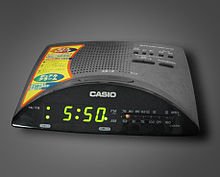|
Broadcast radio receiver The most familiar form of radio receiver is a broadcast radio receiver, often just called a broadcast receiver or simply a radio, as used for radio broadcasting. It receives audio programs intended for public reception transmitted by local radio stations. The sound is reproduced either by a loudspeaker in the radio or an earphone which plugs into a jack on the radio. The radio requires electric power, provided either by batteries inside the radio or a power cord which plugs into an electric outlet. All radios have a volume control to adjust the loudness of the audio, and some type of "tuning" control to select the radio station to be received. Modulation typesModulation is the process of adding information to a radio carrier wave. AM and FMTwo types of modulation are used in analog radio broadcasting systems; AM and FM. In amplitude modulation (AM) the strength of the radio signal is varied by the audio signal. AM broadcasting is allowed in the AM broadcast bands which are between 148 and 283 kHz in the longwave range, and between 526 and 1706 kHz in the medium frequency (MF) range of the radio spectrum. AM broadcasting is also permitted in shortwave bands, between about 2.3 and 26 MHz, which are used for long distance international broadcasting. In frequency modulation (FM), the frequency of the radio signal is varied slightly by the audio signal. FM broadcasting is permitted in the FM broadcast bands between about 65 and 108 MHz in the very high frequency (VHF) range. The exact frequency ranges vary somewhat in different countries. FM stereo radio stations broadcast in stereophonic sound (stereo), transmitting two sound channels representing left and right microphones. A stereo receiver contains the additional circuits and parallel signal paths to reproduce the two separate channels. A monaural receiver, in contrast, only receives a single audio channel that is a combination (sum) of the left and right channels.[1][2][3] While AM stereo transmitters and receivers exist, they have not achieved the popularity of FM stereo. Most modern radios are able to receive both AM and FM radio stations, and have a switch to select which band to receive; these are called AM/FM radios. Digital audio broadcasting (DAB)Digital audio broadcasting (DAB) is an advanced radio technology which debuted in some countries in 1998 that transmits audio from terrestrial radio stations as a digital signal rather than an analog signal as AM and FM do. Its advantages are that DAB has the potential to provide higher quality sound than FM (although many stations do not choose to transmit at such high quality), has greater immunity to radio noise and interference, makes better use of scarce radio spectrum bandwidth, and provides advanced user features such as electronic program guide, sports commentaries, and image slideshows. Its disadvantage is that it is incompatible with previous radios so that a new DAB receiver must be purchased. As of 2017, 38 countries offer DAB, with 2,100 stations serving listening areas containing 420 million people. The United States and Canada have chosen not to implement DAB. DAB radio stations work differently from AM or FM stations: a single DAB station transmits a wide 1,500 kHz bandwidth signal that carries from 9 to 12 channels from which the listener can choose. Broadcasters can transmit a channel at a range of different bit rates, so different channels can have different audio quality. In different countries DAB stations broadcast in either Band III (174–240 MHz) or L band (1.452–1.492 GHz). Types Radios are manufactured in a range of styles and functions:
References
Information related to Broadcast radio receiver |